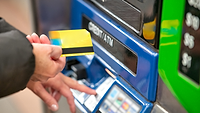Implementing next-gen retail technology to improve security & mitigate fraud

In today’s fluctuating retail environment, meeting shoppers’ growing expectations isn’t enough. Retailers must stay ahead of them.
Today’s consumers are empowered and connected like never before. In the wake of the pandemic, retailers and shoppers alike were forced to make the leap to digital. A Google survey found that by mid-year 2020, 50% of consumers tried new shopping services for the first time; more than one-quarter shopped online for things they previously purchased in-store; and more than half said their interest was piqued by curbside pickup.
Before any of us had ever heard of COVID-19, dynamic changes in retail were underway. But 2020 ushered in an industry-wide seismic disruption that required technology to give retailers the agility and ability to adapt – and also to increase storewide and channel-wide security.
Following are some emerging technologies that have taken the retail world by storm and ways they can help physical and omni-channel retailers improve security with a digital-first approach.
Curb security threats with contactless
New mobile payment methods benefit retailers and customers alike. Contactless options enable transactions to be made safely and like the name implies with no contact, which is of utmost importance to help protect employees and customers. These options also increase security.
EMV cards are safer and more secure than those with a magnetic strip and most retail segments have introduced EMV-compliant payment terminals. These terminals generate a one-time code for every payment, making it more challenging for a scammer to steal credit and debit card information. The unique cryptogram embedded in EMV payment cards make it too difficult or expensive to fake.
These cards can also facilitate tap-to-pay, which enables physical safety, not only by being contactless but through radio waves that use a one-time encrypted number to quickly and securely process transactions. By using these terminals, brick-and-mortar retailers can legitimize in-store purchases quickly and securely.
Lastly, not upgrading could cost some retailers more than security. After April of this year, fuel retailers – rather than credit and debit card companies – will be required to pay for theft committed at gas pumps without EMV readers as the last retail industry. And yet, the Fall 2020 Conexxus EMV Survey found that 31% of convenience stores have failed to upgrade their pumps for compliance.
Overall, making the leap to EMV will give retailers added security by both protecting sensitive data and reducing unnecessary physical contact at checkout.
Deter theft with POS self-scanners
For retailers themselves, touch-free technology and platforms like self-scanners can increase efficiencies, speed up the time of checkout and address current shopper preferences, all while reducing the risk of theft.
But implementing these solutions requires more than simply installing the technology. Here are a few key things that can cut down on self-checkout (SCO) shrink:
- A self-checkout attendant should man the area as theft is less likely to occur when a cashier is in-site. When SCOs are staffed by an attendant, customer theft can drop by as much as 90%.
- The POS system should include built-in security scales and scanner cameras. The scale recognizes when an unscanned or improperly scanned item is placed in the bagging area (or vice versa). The security camera visually recognizes a product from an image database to confirm an item really is what the shopper inputs. These two technologies combined will help ensure that all items are correctly scanned and bagged, reducing the likelihood of theft.
- All items must be correctly priced and available to customers in the store’s database. If an item isn’t readily accessible in the database, and an employee isn’t there to assist manually, customers often get frustrated and may simply walk away with the item. Ensure your database is up to date to avoid unnecessary irritation.
- Mobile scanning should be introduced to incentivize loyalty customers. Using mobile apps, retail associates can cut down on long queues at SCOs by delivering checkout services anywhere on the sales floor. By alleviating congestion at the front of the store, retailers are likely to see less shrink from frustrated shoppers and create a superior experience to drive brand loyalty.
And while these methods are a great place to start with a more secure self-checkout, forward-thinking retailers can go even further with technologies like AI.
Reduce unauthorized purchases with facial recognition tech
Another solution that helps retailers increase security is facial recognition technology, which alerts retailers when shoppers attempt to purchase certain items, like age-restricted goods. Self-checkout machines equipped with this technology use a camera to scan a shopper’s face and determine certain key data, such as estimating his or her age.
The penalties and fines for selling products that include alcohol, cigarettes, cigars and vapes to minors are stiff. To avoid such penalties, some UK supermarkets have adopted facial recognition tech to secure their self-checkouts, which use AI to flag minors attempting to purchase alcohol.
While staff should verify the IDs of minors at the checkout, facial recognition technology can be an added layer of security to flag employees and help prevent the purchase of unauthorized items.
Although it has yet to be widely adopted in retail, facial recognition technology can help retailers increase security in other facets too, such as reduction in shoplifting or enhancements in CX customization. And nearly half of all Americans support its use to help prevent shoplifting.
Up your safety and security measures with the latest retail tech
The global pandemic has accelerated the digitization of customer interactions by several years. And digital transactions that include next-generation retail technology usage can increase an organization’s security by helping to decrease the likelihood of fraud.
Examples of retail tech in action include EMV chip-embedded debit and credit cards, contactless solutions like self-scanners at the POS and facial recognition technology – all of which increase the safety and security of retailers and consumers alike.
If your organization has taken a platform approach to in-store technology, the addition of new technologies, such as touchless self-checkout, may be incorporated more smoothly with existing IT infrastructure. In addition, there are companies dedicated to helping retailers design, deliver, optimize and accelerate digital transformation with security in mind.
The bottom line is this: fraudsters are masterful at upping their game, and retailers must follow suit to protect themselves and their customers, too. There’s no time like 2021 to double-down on security measures.
Looking for a reprint of this article?
From high-res PDFs to custom plaques, order your copy today!







